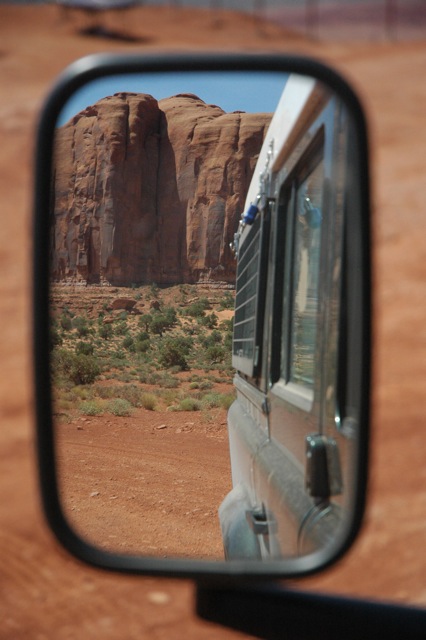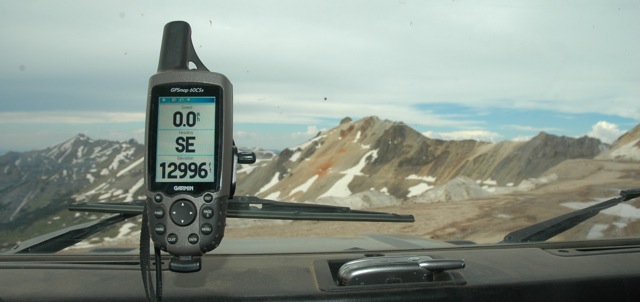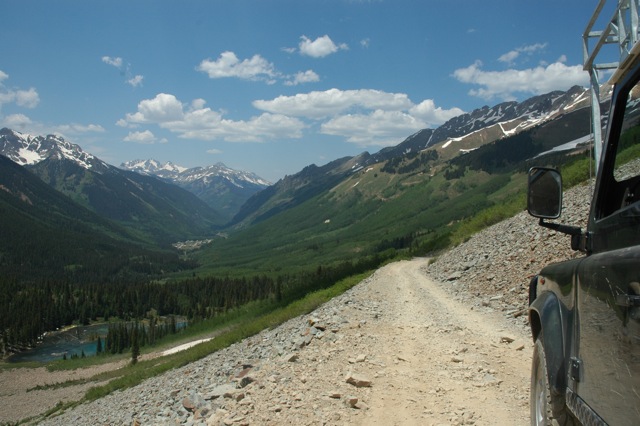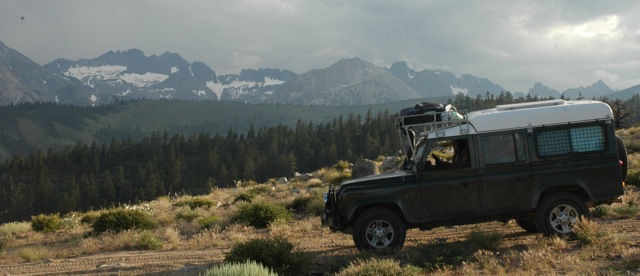The right front wheel of our car is hanging over the edge of the precipice. We are trying to turn the car around but the trail is narrow and runs along a mountainside. It’s steep, it’s high and it’s definitely not how I want to end my days. The car sways, as if considering what to do, and then makes up its mind: “It’s falling!” Cyril shouts.
Utah took me by surprise. One moment we would be struggling through desolated, red deserts and the next, we would pass neat towns with lawns so well groomed a golf course would blush. I fell brutally in love. It was like living out my childhood dream of exploring the American West. Instead of a horse, I had a Defender 110. A smarter choice? Between finding grass and finding diesel in remote Utah, it was pretty much a draw.

Rolling into the small town of Boulder, UT, we made sure to fill up our dear companion with diesel and set off on a gravel road called Burr Trail, which would take us into one of the most inhospitable tracks of land in North America. On the outskirts of town we bumped into two dozen goats being herded on the road. Obviously, Burr Trail wasn’t an Interstate highway. Sooner than expected, Boulder’s last wooden house disappeared in our rearview window. Under a canopy of bright blue sky, the trail took us up and down hair-raising switchbacks, between boulders thrown erratically on the ground and over wide-open spaces. As the hours in this splendid lunar landscape passed, a feeling of freedom filled us with sheer happiness.

Soon we were brought back to reality. We were running low on diesel. After 150 miles, we arrived at the ferry that would take us across Lake Powell to Hall’s Crossing, UT. We had counted on finding a gas station there. Gazing around from the ferry deck, we realized our mistake. Besides a few simple holiday cabins, the sparkling Colorado river was surrounded by bare hills without any sign of a gas station. After the ferry crossing, civilization was lost again. Now we were getting nervous. The fuel gauge was pointing straight down to red, and then the warning lamp lit up. I cursed us for not filling up extra tanks. If we ran dry, simply filling up with diesel would not solve the situation. We would have to be towed. According to our map, we were reasonably close to a small town called Mexican Hat, UT. All we saw, though, was a spectacular desert with red sand and cliffs stretching out to the horizon. Breathtaking to say the truth, but things were too serious to take time to admire the scenery. There was no sign of a house, let alone a gas station. There was nothing else to do but continue. We turned off the air conditioning, rolled up the windows and drove 55 miles an hour to save as much fuel as possible. After several miles through the empty desert, we spotted an enormous cliff in the shape of a sombrero – the Mexican Hat that we had been yearning for! We cheered in relief and happiness. Breathing the last fumes, the Defender rolled into the gas station. One tank of diesel had taken us more than 400 miles: From Boulder to Mexican Hat, including some detours, and mainly in poor road conditions. Diesel definitely takes you farther than gas. As we parked next to the pumps, I patted the car – well done, mate.

Climbing the high mountain passes in Colorado, the Defender was challenged once again. The thin air affected the engine, which growled like an angry dog. At Mosquito Pass, we pushed it to its limit, the GPS’s display marking an altitude of 13,323 feet. It had been the snowiest year in decades so some passes were still closed, even though it was July. During the cold high altitude nights, we experienced, first hand, the limits of the pop-up roof: the wind passed straight through the plastic fabric and left us feeling like deep-frozen fish fingers. Sleeping at over 12,500 feet, just below Engineer Pass, I spent the coldest night in my life, fearing Elin would suffer hypothermia. I didn’t need to worry. Down below, inside the actual car, it was considerably warmer so Elin and Nelson slept like hibernating bears.
While the sun was thawing our cold bones, we explored the narrow switchbacks over the mountain ranges. The ARB air lockers came in very handy, as they allowed us to get a good grip on the lose stones and gravel. In the curves, as the front of the car hovered above the steep descents, I froze with fear and only my pride stopped me from jumping out with Elin in my arms. At least, the stunning scenery compensated the moments of terror.

In Ouray, arguably the 4×4 capital of Colorado, we treated ourselves to a motel visit. Ignoring environmental ethics completely, I indulged in a lavish shower that took me somewhere close to heaven. Then it was time to hit town, i.e. Main Street, which basically means the only street. Nestled between mountains, in the heart of the Rockies, Ouray thrives on 4×4 tourism and is an ideal starting point to explore the surrounding high passes. If you don’t wish to trash your own vehicle, there are plenty of rental agencies or tour companies offering their jeeps. It’s such a popular option that on some mountain trails, the number of rented vehicles we encountered was almost ridiculous, but it was easy enough to divert from the most frequented trails.
Being able to spontaneously decide where and when to go is probably my favorite pat of long, independent travel. We woke up one morning in Colorado, pondering where to go next, and decided to head for the warmth and the beach. Note: The beach was some 1,500 miles away. But what the heck, we were on a road trip. We set off on a three-day, intensive drive westward through the remaining part of Colorado, all of Utah, Nevada and finally California. With Elin, a one year old who had just discovered walking as the best adventure so far, it was quite a mission. We had to get organized. We would get up as soon as Elin would knock on our bed from below, release her from her crib’s enclosure and let her run around as much as possible before starting the day’s drive. If we were lucky, she would fall asleep in the car and wake up two hours later. It would take her roughly half an hour to get the hang of what was going on, and then she would give us the official launch of “HOE”. You don’t know what that means? Neither did I before this road trip. It stands for “Hell On Earth”. It would start with a whimpering into a crescendo of angry high-pitched screams, perfectly summarized as “Hell On Earth”. Older children would verbalize it into “I’ve had enough of this car, let me out!” By then, we immediately had to find a place to stop for lunch so Elin could run around for a bit. Time pressure doesn’t give you the luxury of picking a charming picnic area. Once we parked under a highway bridge, eating our sandwiches while brushing away broken beer bottles with our shoes, rancid odors whiffing into our noses, and trailer trucks roaring past on the interstate above us; so much for the 4×4 wilderness trip….

After the epic snow season of Colorado, parts of California were ablaze with some of the worst wildfires in years. Fortunately, we were able to get through when the firemen opened the road to the coastal town of Arcata for only a few hours. We drove through intense heat and thick smoke and finally made it to the Pacific. Nelson threw himself in the waves and Elin played happily in the sand. So we finally had what our friends and families had suggested: a family beach holiday. We just took the long way to get there. Of course, we soon got itchy feet. Redwood National Park was around the corner, so we wanted to go hiking. Standing on the soft moss I looked up at the gigantic Redwood trees and felt as tiny as a hobbit from Tolkien’s tales. The thick trunks and tree canopies sealed off sounds and the silence that remained felt otherworldly.

Drawn to more forests and mountains, we decided to go to Sierra Nevada, in eastern California. Here, the pine trees were normal sized but, instead, needle sharp gray peaks pierced the sky above turquoise glacier lakes, creating another outlandish environment. During our trip I had constantly been feeding off impression kicks brought on by the spectacular changes in scenery. It was easy to become addicted. A 4×4 induced adrenaline boost was the perfect way to top off our bliss. Largest in the Sierra, the Palisades Glacier tempted us, so we decided to follow one of the trails described in our 4×4 guidebook as moderately difficult to see it up close. The problems started immediately. Since parts of the forest we were to drive through had burnt down, the directions were useless and we made wrong turns and backtracked several times. Then a steep and sandy hill proved to be tricky even for the air lockers. It was only after having placed big stones in front of the wheels and Cyril accelerating like a maniac, that we made it up the sandy hill. As the map-reader, I gave directions from the guidebook. I was reading a long paragraph about the wildflowers of the Sierra when we found ourselves struggling on a narrow trail composed of large rocks. Careful not to scratch the sides of the car, Cyril zigzagged between the boulders. Then we came to a full stop. In front of us, two huge rocks had fallen down on the trail and made it impossible to continue. The problem was that there was no place to turn around. The track was very narrow and ran along a steep mountainside. Reversing through this highly technical trail created too great a risk of tipping over. I asked myself: how could the author describe this as only a moderate trail? Cursing my stupidity, I realized I had done a classic mistake. Instead of reading the whole road description before setting off, I had been reading as we were driving. Hence, I had been caught up in the paragraph about the wildflowers, missing the subsequent section where the author specifically warned against continuing, as the trail had been wiped away and the conditions were dangerous beyond that point. That’s precisely where we were standing, smack in the middle of immediate danger. I looked down the precipice. It was steep and deep. I wished we’d had a friend who could come and pick us up… with a Chinook! We didn’t, so we had to somehow turn around. First of all, we evacuated the vessel. Nelson jumped out, I grabbed Elin and was going to give instructions to Cyril who, as the heroic captain, volunteered to do the maneuvering. Inch by inch, he backed as much as possible, up against the slope, then released the handbrake and steered over the precipice, repeating the routine several times, making little progress each time. Suddenly, the Defender started to tip over and one wheel swayed in the air, as if deciding whether to stay or go.
“It’s falling!” Cyril yelled.
Time seemed to stop. Cyril had frozen, we were quiet and watching the Defender slowly swinging in the air. I glanced down the steep cliff. I hadn’t planned on becoming a widow this young. Then the car made up its mind. The front wheel gradually sank down to the ground, as if still reflecting on the decision. Sighing in relief but still pale and silent, we managed to turn the Defender around completely, after several surgical maneuvers, and drive back through the boulders. As soon as we got back to the safe area, we sat down among the wildflowers; cursed them, and popped open a couple of beers. We would hardly be praised as responsible parents, and decided not to tell our families. Elin was playing in the grass and Nelson was resting beside us. Sipping my beer, I watched the late afternoon sun flickering over Palisades Glacier and the rugged Sierra. Our trip would soon be over, but it didn’t matter.
There and then, life was the most wonderful thing there was.

Tips for successful overlanding with children.
- Generally, it’s probably easier to do a road trip either before a child has turned one or when they are three and up.
- Adjust the driving time according to your children’s patience. If you have to drive long distances, make sure to take long breaks so your kids can burn some of their amazing energy. In the worst case, consider driving at night or in the early mornings, if you can stay awake.
- Don’t pack too many clothes or toys. Kids make do with much less than we think. If something is missing, you can buy it during the trip.
- Make sure the clothes are easily washable and suit the climates you will travel through.
- The car seat should be comfortable and easy to use.
- Understand the limits: home cooked meals for your little darling is a hassle when traveling, so settle for easier alternatives, like canned baby food, sandwiches and fruits. I can promise that your child’s development is not threatened – soon you’ll be back home and can pick up the wholesome cuisine.
- Take turns with the toys when playing in the car so that there are always some “new” ones to use when a crisis arises.
- Have fun!


